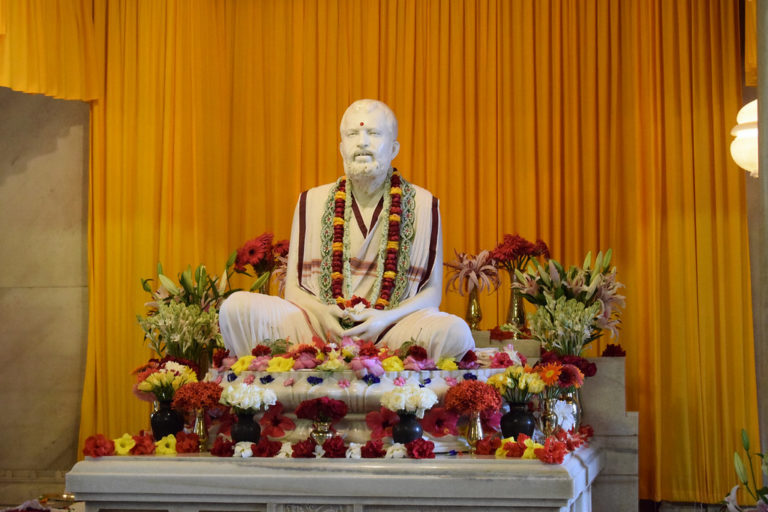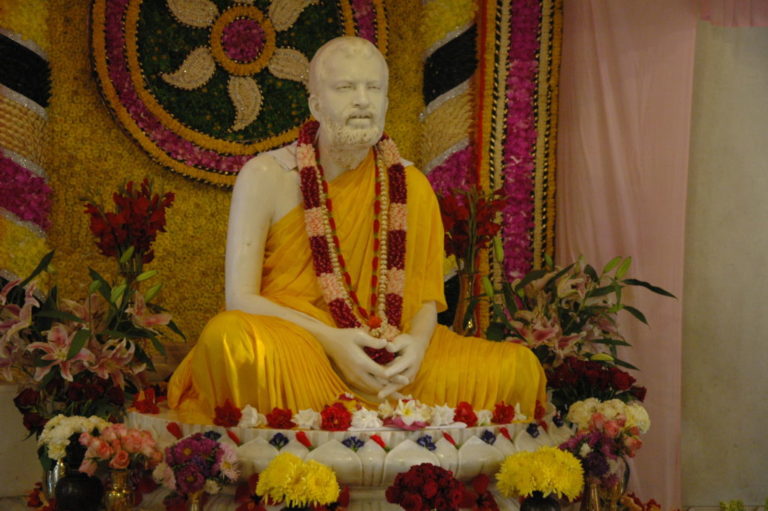Sri Ramakrishna had by now practised all the different phases of devotion laid down in the scriptures of Bhakti, namely, Shanta, Dasya, Sakhya, Vatsalya, and Madhura, and realized the same goal through each one of them. His spiritual experience, hither to gathered, had many forms. Sometimes he willed himself into them, at other times the strong current of his spiritual nature swept him into them inspite of himself. He would commune with invisible beings – forms of the Divinity or Divine Incarnations of the past. Such visions, however, belong to the domain of personality, which is not the last word in spiritual experiences. He was yet to reach a state where knowledge, knower, and known become one indivisible Consciousness – a state in which space disappears into nothingness, time is swallowed up in Eternity, causation becomes a dream of the past.
(Shanta is the placid attitude of mind towards Divinity, Dasya is the relation of servant to master, Sakhya is the attitude of friendship, Vatsalya is the relation of parent and child, and Madhura, the highest, is the relation between two lovers.)
He only knows that state who has experienced it. It is all stillness indefinable. The soul after a final struggle leaps over the last barrier of relative existence, shatters its prison of matter, and merges in the infinite glory of Brahman. This is called the Nirvikalpa Samadhi – the highest flight of Advaita philosophy. This is the crowning glory of man’s spiritual exercises – the last word in his evolution. Then there is no more birth, no more death, nor any further identification with the changes of the body. He leaves behind all the modifications of relativity like a cast-off garment. He realizes his identity with the Eternal Brahman, the One without a second. There is no doubt Sri Ramakrishna was the fittest person to realize this state. The field was ready ploughed, and waited only for the sowing of the seed.
At this time there came to the garden of Dakshineswar a wonderful monk, Totapuri by name. He was a Punjabi by birth and had renounced the world while quite young. He had been initiated by a Yogi who was the head of a monastery of the Naga sect at Ludhiana in the Punjab. It is said that he practised Sadhana in a secluded forest on the banks of the sacred Narmada and attained to the Nirvikalpa Samadhi after rigid discipline extending over forty years. After the passing away of his Guru, Totapuri took his place as the head of the monastery. A liberated soul, indifferent to the joys and sorrows of the world, he intended to spend the remaining years of his life in making pilgrimages to holy places. Like a lion he roamed at will over the country. He had been to Puri and Gangasagar and on the return journey along the course of the Ganga, halted at Dakshineswar, where he met with Sri Ramakrishna.
The bright face of the Master at once arrested the attention of Totapuri, who came to understand that Sri Ramakrishna was a highly advanced seeker after truth. Greatly impressed by him Totapuri asked, ‘Would you like to learn Vedanta?’
‘I do not know. It all depends on my Mother. I can agree to your proposal only if She approves of it, ‘was the quiet answer.
‘All right,’ said the monk, ‘go and ask your mother. I shall not be here long.’
Sri Ramakrishna went into the Kali temple and spoke of the matter to the Mother and in a state of trance heard Her command: ‘Yes, my boy, go and learn of him. It is for this purpose that he has come here.’ In a state of semiconsciousness and with a beaming countenance, Sri Ramakrishna returned and said to Totapuri that he had his Mother’s permission. Totapuri could not help smiling at his apparent superstition in addressing the image in the temple as Mother, for, as a Vedantist, he looked upon Shakti – the kinetic state of Brahman, which Sri Ramakrishna worshipped as Mother – as nothing but an illusion. However, he said nothing to Sri Ramakrishna on this point, thinking that under his training the disciple would soon learn the truth and spontaneously brush aside all super-stitions.
Sri Ramakrishna had to be initiated into the sacred order of Sannyasa, before he could commence studying the truths of Vedanta. He said that he had no objection provided he could do so in private, for it would be too much for his aged mother, who was living at that time in the sacred precincts of the Dakshineswar Temple, to see her son shave his head and take the monk’s vow. To this Totapuri agreed. When the auspicious day arrived, Totapuri asked his disciple to per form the preliminary ceremonies. He went through all these exactly as he was told. The night was almost spent. The teacher and the disciple entered the meditation room. The Guru chanted the holy Mantras, which the disciple repeated as he put oblations one after another into the sacred fire, renouncing, as he did so, all desire for enjoyments, here and hereafter.
Prostrating himself before his Guru, Sri Ramakrishna took his seat to receive his instructions in
Advaita (monistic) Vedanta. ‘Brahman,’ said Totapuri, ‘is the only Reality, ever-free, beyond the
limits of time, space, and causation. When a seeker is merged in the beatitude of Samadhi, he does not perceive time and space, nor name and form-the products of inscrutable Maya. Pierce through the maze of name and form and rush out of it like a lion. Dive deep in the search for the Self and be firmly established in It through Samadhi.’ Totapuri thus tried that day to help Sri Ramakrishna to fix his mind firmly on the Absolute. We describe it in Sri Ramakrishna’s own words: ‘After the initiation’ the naked one’… asked me to withdraw the mind completely from all objects and dive into the Atman (Self)….I had no difficulty in withdrawing the mind from all other objects except one, the all too familiar form of the Blissful Mother-radiant and of the essence of Pure Consciousness – which appeared before me as a living Reality preventing me from passing beyond the realm of name and form. ‘In despair I said to ìthe naked one’, ‘It is hopeless. I cannot raise my mind to the unconditioned state and come face to face with the Atman’. He grew excited and sharply said, ‘What! you canít do it! But you have to!î He cast his eyes around, and finding a piece of glass he took it up and pressing the point between my eyebrows said, ‘Concentrate the mind on this point.’ Then with astern determination I again sat to meditate, and as soon as the gracious form of the Divine Mother appeared before me, I used my discrimination as a sword and severed it in to two.
(Sri Ramakrishna used to refer to Totapuri as Nyangta, i.e. the naked one.)
There remained no more obstruction to my mind, which at once soared beyond the relative plane, and I lost myself in Samadhi!’
Totapuri sat for a long time, silently watching his disciple. Finding him perfectly motionless, he locked the door and went out of the room. Three days passed, and still there was no call. In utter surprise Totapuri opened the door and found Sri Ramakrishna sitting in the very same position in which he had left him. With breathless wonder Totapuri stood before this august spectacle. ‘Is it really true?’ he said to himself, ‘Is it possible that this man has attained in the course of a single day that which it took me forty years of strenuous practice to achieve?’ Impelled by doubt, he made a searching examination. In joyous bewilderment he cried out, ‘Great God, it is nothing short of a miracle!’ It was undoubtedly a case of Nirvikalpa Samadhi – the culmination of the Advaita practice! Totapuri immediately took steps to bring the mind of Sri Ramakrishna down to the world of phenomena. Little by little he came to the consciousness of the outside universe. He opened his eyes and saw his Guru looking at him with tenderness and admiration. The Guru answered the worthy disciple’s prostration by locking him in a warm embrace.
Totapuri usually did not stay at any one place for more than three days. But he wished to establish his wonderful new disciple firmly on the lofty pinnacle of Advaita. So he remained eleven months in the garden of Dakshineswar. During this time Totapuri also under went some mental transformation. We have seen how he looked upon Sri Ramakrishna’s praying to the Divine Mother as a superstition. But circumstances compelled Totapuri to believe in the existence of the Divine Mother. Before he left Dakshineswar he realized that Brahman and Shakti are one and the same thing-the two aspects of the same entity.
After Totapuri had left Dakshineswar, the Master was determined to remain in a state of absolute identity with Brahman, far above all subjective and objective experiences. He remained in that state for six months. Referring to this period of his life the Master used to say: ‘For six months at a stretch I remained in that state whence ordinary men can never returnóthe body falling off after three weeks like a sere leaf. I was not conscious of day and night. Flies would enter my mouth and nostrils just as they do in a dead body, but I did not feel them. The hair became matted with accretions of dust. There was no chance for the body to survive, it would certainly have perished but for the kind ministrations of a monk who was present at Dakshineswar at the time….He would bring food regularly to me…and as soon as he found me to be a little conscious, he would press some food into my mouth, only a bit of which reached my stomach. Six months passed in this way. At last I received the Mother’s command, ‘Remain on the threshold of relative consciousness for the sake of humanity.’ Then I was laid up with a terrible attack of dysentery….It went on for six months. Thus only did the mind gradually come down to a lower level and to the consciousness of the body….’

